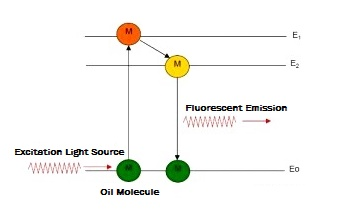What is Fluorescence
Fluorescence technology is based on that light source emit a light on the water sample. The light is typically in the ultra-violet light spectrum. Aromatic hydrocarbons get excited by this light and “fluoresce”.
The amount of “fluorescence” can be quantitated based on the calibration of the actual oil (hydrocarbon) in the oil in water analyzer.
Why Fluorescence based instruments are better than example Light Scatter based instruments.
An example on a typical application for an oil in water monitor located at an oil production facility that uses sea water to cool machinery lubricating oil and the customer wants to protect the environment and his liability by continuously monitoring for leaking oil into the cooling water.
The main flaws in light scatter systems:
- These instruments cannot differentiate between suspended solids and droplets of oil – no matter what the sellers say about dual beams, special circuits, etc. This application is for oil in seawater. Just imagine how much suspended material is in raw sea water. The biggest market for these instruments is the shipping industry and they absolutely do not measure oil. In fact is it common that the ship industry do not believe their oil in water instrument readings.
- Light scatter instruments cannot see oil droplets that are smaller than about 10 – 20 microns. This means that if the oil is finely dispersed or emulsified or dissolved, then the instrument will not see it. The TD-4100 and XD monitor for all the oil. The best example is the capability of our instruments to monitor from very low ppb to over 2000ppm.
- These instruments cannot detect low concentrations of oil in any application. The limit of detection is typical 5 – 15 ppm depending on the application. The accuracy specification they build to is plus or minus 5 ppm.
Infrared technology
Infrared spectrum of oil corresponds to the absorption of energy at specific wavelengths by the molecular bonds while illuminated in the Infrared light range. These instruments use typical expensive solvents and the sampling procedure is more cumbersome. Repeatability is also a challenge using IR technology and difficult to do in the field. Require trained personal.
Gravimetric Analysis (EPA 1664)
Gravimetric analysis measures any material extracted from an oil in water sample by a solvent and is the EPA accepted method (EPA 1664) for oil in water analysis.
These types of analysis can only be done in a lab, are expensive and time consuming. The UVF-500D can replicate Gravimetric Analysis!
Customers who are serious about monitoring oil in water chose Fluorescence based instruments.
